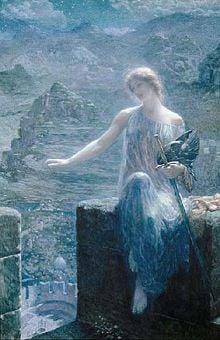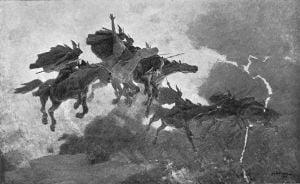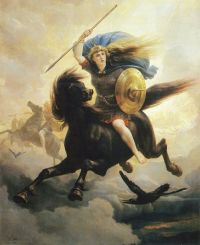In Norse mythology, the Valkyries are female warrior deities who serve Odin (the chief god in Norse pantheon). According to the Prose Edda, âOdin sends [the Valkyries] to every battle. They allot death to men and govern victory.â[1] The primary purpose of the Valkyrie was to select the most heroic of the warriors who had died in battle and to carry them off to Valhalla (Odin's "Hall of the slain"), where they became the deathless einherjar ("lone fighters") who were to fight at Odin's side during the eschaton (Ragnarök).
The Valkyries are esteemed as glorified warrior-maidens, which is a somewhat atypical depiction for women. Nevertheless, their respected military role is paralleled in other religious traditions that place an emphasis on strong female fighting figures: compare, for example, the Prophetess Deborah (in Judaism) and the Goddess Kali (in Hinduism).
Etymology
The word "Valkyrie" comes from the Old Norse valkyrja (plural "valkyrur"), which consists of the words val ("to choose") and kyrja ("slaughter"). Thus, the term literally means choosers of the slain. It is cognate to the Old English wælcyrige. The modern German Walküre, which was coined by Richard Wagner, was derived from the Old Norse.[2]
Valkyries in a Norse Context
As Norse deities, the Valkyries belonged to a complex religious, mythological and cosmological belief system shared by the Scandinavian and Germanic peoples. This mythological tradition, of which the Scandinavian (and particularly Icelandic) sub-groups are best preserved, developed in the period from the first manifestations of religious and material culture in approximately 1000 B.C.E. until the Christianization of the area, a process that occurred primarily from 900-1200 C.E.[3] The tales recorded within this mythological corpus tend to exemplify a unified cultural focus on physical prowess and military might.
Within this framework, Norse cosmology postulates three separate "clans" of deities: the Aesir, the Vanir, and the Jotun. The distinction between Aesir and Vanir is relative, for the two are said to have made peace, exchanged hostages, intermarried and reigned together after a prolonged war. In fact, the most significant divergence between the two groups is in their respective areas of influence, with the Aesir representing war and conquest, and the Vanir representing exploration, fertility and wealth.[4] The Jotun, on the other hand, are seen as a generally malefic (though wise) race of giants who represented the primary adversaries of the Aesir and Vanir.
The primary role of the Valkyries was to swell the ranks of Odin's deathless army by spiriting the "best of the slain" from the battlefield, away to Valhalla. However, it appears that there was no clear distinction between the Valkyries and the Norns because Skuld, for instance, was both a valkyrie and a norn.
Origins and Characteristics

Though the extant texts are silent on the ultimate origin of the mythic Valkyries,[5] many of the well-known Valkyries are reported as having mortal parents:[6] Some scholars now suggest that the original Valkyries were the priestesses of Odin[7]âold women who officiated at sacrificial rites in which prisoners were executed (âgiven to Odinâ). These priestesses sometimes carried out the gruesome sacrifices themselves, which involved the use of a ritual spear. By the time of the Poetic Edda's compilation (in the late twelfth or early thirteenth century), these rituals had given rise to legends of supernatural battle-maidens who took an active part in human conflict, deciding who should live and who should die.[8] Henry Bellows, in the notes to his translation of the Poetic Edda, proposes an alternate interpretation of this historical time-line, suggesting that:
- The conception of the supernatural warrior-maiden was presumably brought to Scandinavia in very early times from the South-Germanic races, and later it was interwoven with the likewise South-Germanic tradition of the swan-maiden ... [A] complication developed when the originally quite human women of the hero-legends were endowed with the qualities of both Valkyries and swan-maidens.[9]
In the mythological poems of the Poetic Edda, the Valkyries are supernatural deities of unknown parentage; they are described as battle-maidens who ride in the ranks of the gods or serve the drinks in Valhalla; they are invariably given unworldly names like Skogul ("Shaker"), Hlok ("Noise," "Battle") and Gol ("Tumult").[10]
Conversely, in the Heroic lays section of the same text, the Valkyries are described as bands of warrior-women, of whom only the leader is ever named. She is invariably a human woman, the beautiful daughter of a great king, though she shares some of the supernatural abilities of her anonymous companions. In the first of the three Helgi Lays, Helgi Hjörvarðsson is accosted by a band of nine Valkyries the leader of whom, Svava, is the daughter of a king called Eylimi. In the second and third lays, the Valkyries are led by Sigrun, who is the daughter of King Hogni; she marries the hero Helgi Hundingsbani and bears him sons. The most famous of the Valkyries, Brynhildr, is also a human princess. In the SigrdrÃfumál (The Ballad of the Victory-Bringer) she is never named, being called simply SigrdrÃfa (âVictory-Bringerâ), and there are only hints that she is not a deity; what's more, we are told nothing of her parentage. In the corresponding passage in the Volsunga saga, however, she is identified as Brynhildr, the daughter of King Budli. (SigrdrÃfa is also identified with Brynhildr in another heroic lay, Helreið Brynhildar, or Bryndhildr's Ride to Hel.)[11]
Notable Valkyries
Various individual Valkyries are mentioned throughout Nordic and Germanic literature.
Major Valkyries
Several Valkyries appear as major characters in extant myths. As mentioned above, they are often depicted as the daughters of human kings who, for whatever reason, were given the task of leading the legion of Valkyries.
- Brynhildr appears in Völsunga saga. Her name means "bright battle."
- Hildr appears in the legend of Hedin and Högni, in Ragnarsdrápa and in the Edda. Her name means "battle."
- SigrdrÃfa appears in SigrdrÃfumál. Her name means "victory-urger."
- Sigrún appears in Helgakviða Hundingsbana II. Her name means "victory rune."
- Sváva appears in Helgakviða Hjörvarðssonar. Her name means "sleep maker."[12]
Other Valkyries
Apart from the well-known Valkyries listed above, the extant mythic corpus also contains numerous lists of additional Valkyries. However, in virtually all of these cases, nothing is known of the figures enumerated therein.
In GrÃmnismál, Odin provides the following catalogue of Valkyries:
- Hrist and Mist | bring the horn at my will,
- Skeggjold and Skogul;
- Hild and Thruth, | Hlok and Herfjotur,
- Gol and Geironul,
- Randgrith and Rathgrith | and Reginleif
- Beer to the warriors bring.[13]
In Völuspá, there are still more names:
- On all sides saw I | Valkyries assemble,
- Ready to ride | to the ranks of the gods;
- Skuld bore the shield, | and Skogul rode next,
- Guth, Hild, Gondul, | and Geirskogul.
- Of Herjan's maidens | the list have ye heard,
- Valkyries ready | to ride o'er the earth.[14]
As can be seen from the above, several of the names exist in different versions. Many of them have a readily apparent warlike meaning - Hjörþrimul, for example, means "battle of swords" while Geirahöð means "battle of spears." However, to what an extent this multitude of names ever represented individual mythological beings with separate characteristics is debatable. It is likely that many of them were never more than names, a contention that is compatible with the fact that only a few occur in extant myths.
Notes
- â Snorri Sturluson, Gylfaginning XXXVI, Brodeur 48.
- â "Valkyrie". Online Etymology Dictionary. Retrieved July 10, 2007. See also: Orchard, 376.
- â Lindow, 6-8. Though some scholars have argued against the homogenizing effect of grouping these various traditions together under the rubric of âNorse Mythology,â the profoundly exploratory/nomadic nature of Viking society tends to overrule such objections. As Thomas DuBois cogently argues, â[w]hatever else we may say about the various peoples of the North during the Viking Age, then, we cannot claim that they were isolated from or ignorant of their neighborsâ¦. As religion expresses the concerns and experiences of its human adherents, so it changes continually in response to cultural, economic, and environmental factors. Ideas and ideals passed between communities with frequency and regularity, leading to and interdependent and intercultural region with broad commonalities of religion and worldview.â (27-28).
- â More specifically, Georges Dumézil, one of the foremost authorities on the Norse tradition and a noted comparitivist, argues quite persuasively that the Aesir/Vanir distinction is a component of a larger triadic division (between ruler gods, warrior gods, and gods of agriculture and commerce) that is echoed among the Indo-European cosmologies (from Vedic India, through Rome and into the Germanic North). Further, he notes that this distinction conforms to patterns of social organization found in all of these societies. See Georges Dumézil's Gods of the Ancient Northmen (especially pgs. xi-xiii, 3-25) for more details.
- â While the Prose and Poetic Eddas do discuss their roles and functions, neither groups of texts explore ontological natures or mythological origins of these beings. This analysis was performed using the online versions of the two texts (the Poetic Edda and the Prose Edda), as the ability to search them electronically greatly reduced the time-intensiveness of such a process.
- â A fact that is attested to in many of the heroic lays of the Poetic Edda (discussed below).
- â As Odin was described as the originator of the Nordic system of sacrifice and worship (see Lindow, 158).
- â This process of historical development, from priestess to minor deity, is discussed in Davidson (1964).
- â Footnote to "Voluspa," in the Poetic Edda, accessed online at sacred-texts.com. pp. 14-31. Retrieved July 10, 2007.
- â See Orchard's "Appendix D: Names of Troll-wives, Giantesses, and Valkyries" (421-423). For accounts of the valkyries in the Poetic Edda, see Voluspa or Grimnismol, both accessible online, retrieved July 10, 2007.
- â These heroic lays are all found in the second half of the Poetic Edda, accessible online at sacred-texts.com. Retrieved July 10, 2007.
- â See Orchard's "Appendix D: Names of Troll-wives, Giantesses, and Valkyries" (421-423).
- â "Grimnismol" (36), Poetic Edda, accessed online at sacred-texts.com. p. 99. Retrieved July 10, 2007.
- â "Voluspa" (31), Poetic Edda, accessed online at sacred-texts.com. p. 14. Retrieved July 10, 2007.
ReferencesISBN links support NWE through referral fees
- Davidson, Hilda Roderick Ellis. Gods and Myths of Northern Europe. Baltimore, MD: Penguin Books, 1964. ISBN 0317530267
- DuBois, Thomas A. Nordic Religions in the Viking Age. Philadelphia, PA: University of Pennsylvania Press, 1999. ISBN 0812217144
- Dumézil, Georges. Gods of the Ancient Northmen. Edited by Einar Haugen; Introduction by C. Scott Littleton and Udo Strutynski. Berkeley, CA: University of California Press, 1973. ISBN 0520020448
- Lindow, John. Handbook of Norse mythology. Santa Barbara, CA: ABC-CLIO, 2001. ISBN 1576072177
- Munch, P. A. Norse Mythology: Legends of Gods and Heroes. In the revision of Magnus Olsen; translated from the Norwegian by Sigurd Bernhard Hustvedt. New York: The American-Scandinavian foundation; London: H. Milford, Oxford University Press, 1926.
- Orchard, Andy. Cassell's Dictionary of Norse Myth and Legend. London: Cassell; New York: Distributed in the United States by Sterling Pub. Co., 2002. ISBN 0304363855
- The Poetic Edda. Translated and with notes by Henry Adams Bellows. Princeton: Princeton University Press, 1936. 151-173. Accessed online at sacred-texts.com. Retrieved July 10, 2007.
- Sturlson, Snorri. The Prose Edda of Snorri Sturluson: Tales from Norse Mythology. Introduced by Sigurdur Nordal; Selected and translated by Jean I. Young. Berkeley, CA: University of California Press, 1954. ISBN 0520012313
- Sturluson, Snorri. The Prose Edda. Translated from the Icelandic and with an introduction by Arthur Gilchrist Brodeur. New York: American-Scandinavian foundation, 1916. Available online at Northvegr.org. Retrieved July 10, 2007.
- Turville-Petre, Gabriel. Myth and Religion of the North: The Religion of Ancient Scandinavia. New York: Holt, Rinehart and Winston, 1964. ISBN 0837174201
Credits
New World Encyclopedia writers and editors rewrote and completed the Wikipedia article in accordance with New World Encyclopedia standards. This article abides by terms of the Creative Commons CC-by-sa 3.0 License (CC-by-sa), which may be used and disseminated with proper attribution. Credit is due under the terms of this license that can reference both the New World Encyclopedia contributors and the selfless volunteer contributors of the Wikimedia Foundation. To cite this article click here for a list of acceptable citing formats.The history of earlier contributions by wikipedians is accessible to researchers here:
The history of this article since it was imported to New World Encyclopedia:
Note: Some restrictions may apply to use of individual images which are separately licensed.

